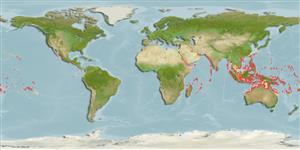>
Tetraodontiformes (Puffers and filefishes) >
Tetraodontidae (Puffers) > Canthigasterinae
Etymology: Canthigaster: Greek, kanthos = the outer or inner corner of the eye, where the lids meet, 1646 + Greek, gaster = stomach (Ref. 45335).
More on author: Richardson.
Issue
Occurrence of this species need to be reviewed.
Environment: milieu / climate zone / depth range / distribution range
Ecología
marino asociado a arrecife; rango de profundidad 10 - 36 m (Ref. 1602). Tropical; 30°N - 24°S
Central Pacific, including Hawaiian Islands. Indian Ocean species were re-identified as Canthigaster petersii (Ref. 123151).
Population from the Philippines, Indonesia, New Guinea, Queensland, and Belau differs in coloration (formerly Canthigaster papua);
Replaced by Canthigaster margaritata in the Red Sea.
Tamaño / Peso / Age
Maturity: Lm ? range ? - ? cm
Max length : 12.1 cm TL macho / no sexado; (Ref. 126022); peso máximo publicado: 32.16 g (Ref. 126022)
Short description
Claves de identificación | Morfología | Morfometría
Espinas dorsales (total) : 0; Radios blandos dorsales (total) : 8 - 10; Espinas anales: 0; Radios blandos anales: 8 - 10. Ocellus at base of dorsal fin; dark lines radiating from eye; caudal fin brown with pale spots, outer rows may form wavy lines (Ref. 4919).
Inhabit sheltered rocky reefs (Ref. 48637). Also live in intertidal reef flats, lagoon and seaward reefs. Occur over open barren areas, also among corals and under ledges (Ref. 9710). Benthopelagic (Ref. 58302). Often found in pairs, sometimes in small groups. Feed mainly on filamentous red and green algae and coralline red algae but also on corals, tunicates, mollusks, echinoderms, polychaetes, crustaceans and bryozoans. Common (Ref. 9710). Monogamous (Ref. 52884).
Life cycle and mating behavior
Maturities | Reproducción | Spawnings | Egg(s) | Fecundities | Larva
Oviparous (Ref. 205). Displays facultative monogamy where males are constrained to mate with a single female due to resource limitation (Ref. 52884).
Matsuura, K., S.V. Bogorodsky, A.O. Mal and T.J. Alpermann, 2020. Canthigaster aziz, a new deep-dwelling toby fish (Tetraodontiformes: Tetraodontidae) from the Red Sea. Zootaxa 4834(1):81-95. (Ref. 123151)
IUCN Red List Status (Ref. 130435)
Threat to humans
Harmless
Human uses
Pesquerías: comercial; Acuario: Comercial
Herramientas
Special reports
Download XML
Fuentes de Internet
Estimates based on models
Preferred temperature (Ref.
123201): 26.1 - 29, mean 28 °C (based on 454 cells).
Phylogenetic diversity index (Ref.
82804): PD
50 = 0.5000 [Uniqueness, from 0.5 = low to 2.0 = high].
Bayesian length-weight: a=0.03090 (0.01814 - 0.05264), b=2.84 (2.69 - 2.99), in cm total length, based on LWR estimates for this species & Genus-body shape (Ref.
93245).
Nivel trófico (Ref.
69278): 3.6 ±0.23 se; based on food items.
Resiliencia (Ref.
120179): Alto, población duplicada en un tiempo mínimo inferior a 15 meses (Preliminary K or Fecundity.).
Fishing Vulnerability (Ref.
59153): Low vulnerability (10 of 100).
Nutrients (Ref.
124155): Calcium = 110 [51, 262] mg/100g; Iron = 1.02 [0.49, 2.36] mg/100g; Protein = 18.1 [15.8, 20.2] %; Omega3 = 0.127 [0.061, 0.255] g/100g; Selenium = 35.6 [16.8, 79.4] μg/100g; VitaminA = 50.2 [13.8, 194.7] μg/100g; Zinc = 1.75 [1.11, 2.63] mg/100g (wet weight);
